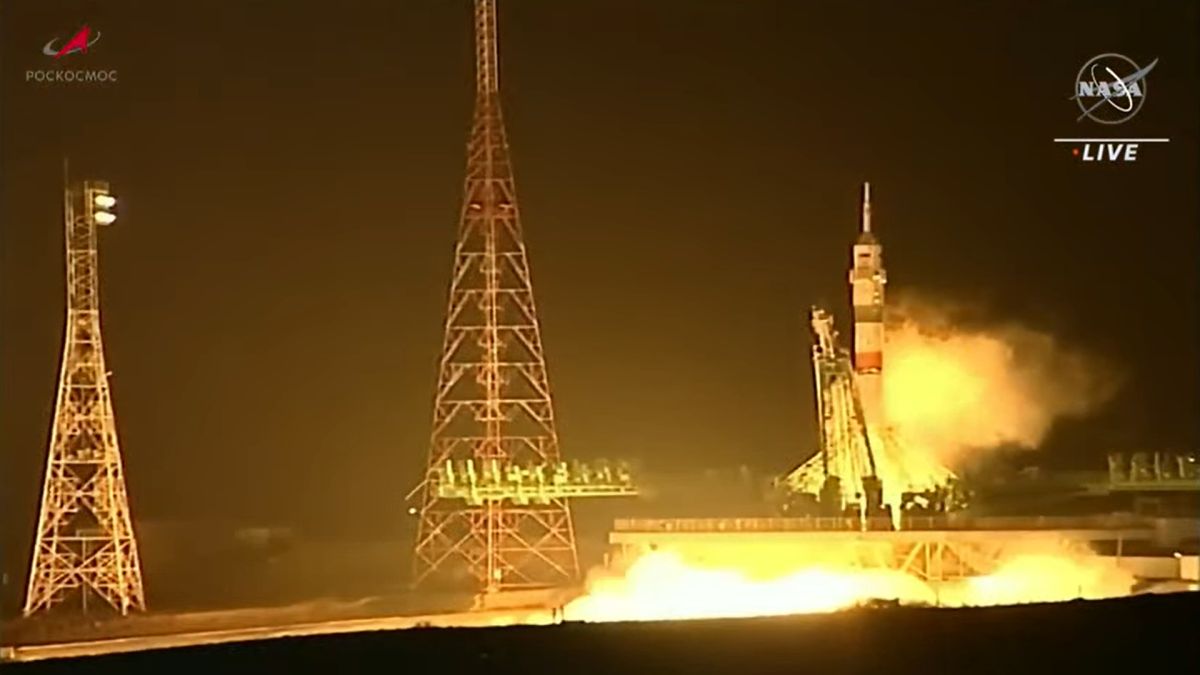
www.space.com
Russia launches Soyuz capsule without crew to replace leaky spaceship at space station
A replacement Soyuz is on the way for three crew members with a leaky craft docked to the International Space Station.
Science & Tech
Relief is on the way for three astronauts who currently depend on a leaky spacecraft docked with the International Space Station.
A replacement Russian Soyuz spacecraft, called MS-23, is bound for the International Space Station (ISS) to be the new ride home for cosmonauts Sergey Prokopyev and Dmitry Petelin and NASA astronaut Frank Rubio. Launch occurred flawlessly Thursday (Feb. 23) from the Russia-run Baikonur Cosmodrome at 7:24 p.m. EST (0024 GMT or 3:34 a.m. local time Friday, Feb. 24).
"A nominal ascent into orbit for Soyuz MS-23," NASA spokesperson Rob Navias said during live launch commentary. "A perfect ride to orbit for the vehicle that will bring home Frank Rubio, Sergey Prokopyev and Dmitry Petelin later this year."
Soyuz MS-23 is scheduled to dock with the ISS on Saturday (Feb. 25) to finally give the three crew members a fully functional lifeboat for the first time in two months following a coolant leak on their older Soyuz MS-22. Docking is expected at 8:01 p.m. EST Feb. 26 (0101 GMT Feb. 27) and will be carried live here at Space.com, via NASA Television (opens in new tab).
The Soyuz launch and docking take place amid a very busy week for ISS activities, as SpaceX's Crew-6 Crew Dragon spacecraft is expected to launch four astronauts for NASA on Monday (Feb. 27) for its own docking about 24 hours later. Both events will be simulcast on Space.com from NASA Television.
Troubles for the trio of Expedition 69 crew members began on Dec. 14 after their docked Soyuz, called MS-22, sprung a coolant leak. While the incident posed no immediate threat to the ISS or its activities, Russian federal space agency Roscosmos determined a new Soyuz was needed to replace the leaky MS-22. A micrometeoroid impact on the Soyuz has been cited as the leak's cause, Roscosmos has said.
Scheduling that Soyuz launch ran into quite a few hiccups. At first, Soyuz MS-23 was scheduled to fly a normal crew replacement mission for the late spring. Roscosmos pushed it up to Feb. 19 and elected to launch it without crew, to give three full seats for the stuck Soyuz MS-22 crew. Instead of people, it is carrying 945 pounds of supplies and a toy teddy bear to serve as a weightlessness indicator.
There were options to bring the crew home in the meantime in case of emergency; two cosmonauts could use the damaged MS-22, Roscosmos said, as two crew members would heat up the spacecraft to a lesser degree than three. Rubio, meanwhile, would use an extra seat on the already docked SpaceX Crew-5 spacecraft, joining four other astronauts should the need to leave the ISS arise.
The schedule of launching Soyuz MS-23 was further complicated after a Progress-82 freighter coolant leak at the complex on Feb. 11. At first, Roscosmos held the launch of Soyuz MS-23 until March in case the two spacecraft had related leaks. Fresh pictures of Progress after the scheduled undocking on Feb. 17, however, allowed Roscosmos to push through an accelerated Soyuz launch date of Feb. 23.
The two coolant leaks, Roscosmos officials determined, were not related and were caused by separate micrometeoroid strikes on each spacecraft. Nevertheless, the schedule shuffle has caused a big change to ISS activities: The three Soyuz MS-22/MS-23 crew members will double their time in space to about a year, to September 2023.
The extra time in space will allow Roscosmos to launch yet another Soyuz, this time with crew, to serve as relief for the trio of Expedition 69 crew members. The crewed Soyuz MS-24 will likely launch in September, according to the SpaceflightNow launch calendar.
























































